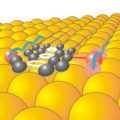
Molecular “computations” are essential for the survival of all organisms. To work, the molecules must pinpoint and then bind to specific counterparts while swimming in a thick, erratic molecular stew – a bit like finding a friend in a busy subway station during rush hour.
In the traditional view of molecular recognition, the binding molecules fit each other like a lock and key, but research has shown that in numerous cases, the molecules need to deform in order to bind, as the “key” is not an exact fit for the molecular “lock”. Biologists have long puzzled over why evolution chose such an inexact system.
But the researchers’ model shows that the key’s deformation actually helps in discerning the right target. Although the energy required to deform the molecular key slightly lowers the probability of its binding to the right target, it also reduces the probability that it will bind to a wrong one by quite a bit. Thus, the quality of recognition – i.e. the ratio of the right to wrong binding probabilities – increases.
This simple mechanism – known as “conformational proofreading” – may explain the observed deformations in many biological recognition systems. Furthermore, conformational proofreading may turn out be a crucial factor affecting the evolution of biological systems, say the researchers.
Related Articles:
Biochemical “Noise” Critical For Regulating Biological Processes
Designed By Mother Nature
Prof Questions Darwinian Dogma








Comments are closed.